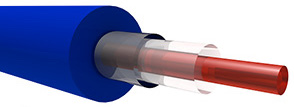
It seems that everything we do these days from checking Instagram to streaming Netflix relies on good network connections within the home and to the Internet. We talked about how to build a great home Wi-Fi network, but there is a lot more to the story for a home network – its the wired network that does the heavy lifting. A great wired home network requires proper cabling in the walls, planning where to run the cabling, and the proper equipment.
The first part to get right is what cabling to put into your home’s walls to get all your data moving around with ease. Our go to is Cat 6 networking cable, as it offers good data rates, reasonable cost, and good workability for electricians to pull through a home. It offers 1 Gbps data rates (current top speed of consumer gear), and for lengths of up to around 30-50 meters, it should be able get up to 10 Gbps. The next step up in network cabling is Cat 6a. It allows up to 10 Gbps up to the max 100 meters. Cat 6a can run higher data bandwidths because its eight wires are twisted together with more careful spacing than Cat 6. But this makes Cat 6a more expensive, thicker and harder to install. These Category (“Cat”) cables can also be be shielded with aluminum foil to help keep electrical interference away. This ensures data rates can be as fast as possible. Cat 7 takes it to another level and cost. Its also worth looking at fibre optic cable, as fibre can allow 10 Gbps, isn’t bothered by electrical interference, and costs are coming down. Fibre is also getting easier to work with as companies like Cleerline are making more rugged optical cable.
fibre optic cable, as fibre can allow 10 Gbps, isn’t bothered by electrical interference, and costs are coming down. Fibre is also getting easier to work with as companies like Cleerline are making more rugged optical cable.
Next, you have to think about where to run cabling to. Run it to all the places that need data: AV media rooms, Wi-Fi access points, computers, printers, etc. Basically run to anywhere you would conceivably have home tech that can be plugged into the network. This way your Wi-Fi is left for devices like smart phones and tablets. Although running cables isn’t free, its way more cost effective and convenient to run wires during construction than after the fact. To mitigate costs and maximize future proofing, you can have a dual strategy: run Cat 6 as usual, and double up runs to places like AV media centres with something like shielded Cat 6 or optical cable. As devices like media streamers will likely be increasingly data hungry, especially with 4K UHDTV, this should help cover you for the future.
Finally there is the networking equipment like routers and IP switches that actually enable your home’s network. As mentioned earlier when focusing on the Wi-Fi part of your network, cheap gear is, well, cheap. If you and you family use and value your home network for activities like work, streaming media, and playing video games, then there is likely a lot of data pumping through your home. Even an average family home uses more data and Internet bandwidth than most people realize. Imagine what happens when you layer on even more home tech like 4K TV content, lighting automation and video surveillance, This is why your network gear needs to be well thought out for functionality, performance and reliability. You need to choose all network routers and switches to handle your home data load without bottlenecks. Fast equipment like 1 Gbps is common now, but gear must also be trustworthy. It may be tempting to try save money and buy equipment that is less expensive, but you need gear that is designed to be robust and run pain free for years. You end up paying for it one way or another. Some professional home tech equipment allows for remote fixes as well – a nice feature so you don’t have to wait for a scheduled service appointed if something does go wrong.
Planning a home network may be a lot to think about, but the reality is that technology in the home is only growing and needs the right foundation. It will be well worth the cost and effort to get it right when you’re building or renovating – use the right cable, to the right places, and with the right equipment. As with anything in your home, from painting to hot water tanks, some maintenance is expected, but its minor when your network infrastructure is solid. With a well designed network, you and your family can just focus on doing the things you enjoy.
